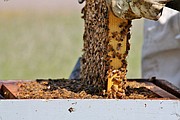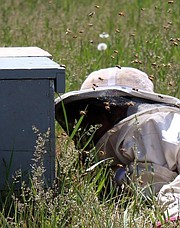Bees are amazing creatures
It’s hard to talk about honeybees and not discuss two major topics, one is the health benefits of honey and the other is Colony Collapse Disorder and the fears surrounding the disappearance of the bees.
When talking to a bee enthusiast, like Kavita Bay, owner of Hindu Hillbilly and Rivulet Apiaries, the two topics seem to be intertwined.
“They (bees) just blow me away, they’re amazing creatures,” said Kavita from her home in Rivulet, located up Fish Creek.
She shares her apiary with husband, Justin, and children Cy and Sujatha. They’ve been raising bees since 2009 and now have around 100 hives which can produce as much as 75 to 100 pounds of honey in a year.
They also sell nucs which is a hive with an accepted laying queen. Raising bees is comparable to growing a garden. It’s not difficult but it takes times and patience and there is a learning curve.
“I always tell people not to be afraid of failure, you just need to be dedicated and continue to learn and try again. It’s like a vegetable garden, you may do something wrong and your garden doesn’t grow and you don’t find out until it’s too late. Then you just have to try again next summer,” she said.
People who have honeybees in their yards find that their gardens and orchards produce better. Plus, there’s the honey. Raw honey has several health benefits. It helps fight allergies, it’s a good source of antioxidants, it has healing properties, helps with digestive issues, and can soothe a sore throat. More specifically it contains 22 amino acids, 27 minerals and 5,000 enzymes. Along with iron, zinc, potassium, calcium, phosphorous, magnesium and selenium, plus a long list of vitamins.
Oftentimes, store bought honey has been pasteurized and has filtered out most of its healing benefits including vitamins and enzymes. But honey doesn’t need to be pasteurized, “it’s the only food that never goes bad,” said Kavita, “Egyptian tombs had honey that was still good to eat.”
According to an article in National Geographic, honey dating back approximately 3,000 years, was still perfectly edible. The secret behind honey’s eternal shelf life is a range of factors. Hydrogen peroxide, acidity and lack of water work together to make this sticky substance last forever, the article stated.
Montana is the second largest honey producer in the nation according to U.S. Department of Agriculture statistics. In Mineral County there are more than 20 registered apiary locations. In 2013, nearly 15 million pounds of honey was harvested, worth more than $31 million. But honey isn’t the only golden ring for beekeepers, pollination fees help to fill the coffers, as well.
Bees have become valuable in other states, particularly for California almond crops. Where 10 percent of the estimated 1.6 million hives sent there each year come from Montana. California almond crops produce around 82 percent of the world’s almonds and growers are willing to pay beekeepers $175 per hive to pollinate their orchards.
A part of the need to transport bees for pollination stems from Colony Collapse Disorder. This was a strange phenomenon which became apparent around 2006 where billions of bees flew from their hives and simply disappeared. But nobody knew why.
Since that time, a number of factors have been found as what’s been killing the bees including pesticides, herbicides, viruses, and mites. There is definitely a heightened awareness of what’s been going in the world of bees and people’s interest in raising them is a good thing.
“It’s a new popular hobby, like when everyone wanted to raise chickens. It’s a good thing because it increases pollinators,” Kavita said.
Monoculture is another problem that could be causing bees to disappear. As states grow large crops such as soybeans, corn, and grains, there simply isn’t enough biodiversity, or food, for the bees.
“Fifty years ago, bees really didn’t require much maintenance. Now, there’s things like disease and mites and we have to really pay attention to the hives in order for them to survive. Commercial beekeepers can lose up to 30 percent of their hives,” said Kavita. “There’s many layers that contribute to Colony Collapse, it’s a living system and you need biodiversity and healthy conditions in order to survive. It’s the same thing if you use synthetic fertilizers in your garden soil instead of compost. Compost creates good natural bacteria which feeds the soil and keeps the process going in a healthy cycle. If you use synthetic fertilizers, eventually the soil is dead and not sustainable.”
As with many things in life, it’s the little things that can make a big difference. Since the biggest Colony collapse in 2006, bee populations have been in an upward trend with 2.66 million commercial honey-producing bee colonies in the U.S. in 2015. This is partly due to an increased awareness of insecticides and herbicides and their impact on bees.





